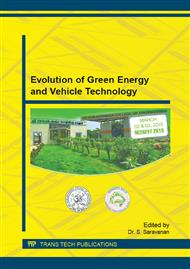p.51
p.60
p.64
p.70
p.79
p.87
p.93
p.102
p.107
Optimal Blend for the Performance and Emission Analysis of C.I & V.C.R Engine Fuelled with Animal Tallow Methyl Esters (ATME) Blended with Diesels
Abstract:
This Paper deals with the study of the potential substitution of Animal Tallow Methyl Ester (ATME) Blends for diesel as fuel for automobiles and other industrial purpose.The objective of this paper is to analyse the performance and emission characteristics of the animal tallow methyl esters and comparing them with petroleum diesel. The tests were carried out on a 3.5 KW, single cylinder, and direct injection engine. Engine tests have been carried out on 20% increase in steps of ATME blends with the aim of obtaining comparative measures of brake power, specific fuel consumption and emissions such as CO2, CO, HC, smoke density and NOx to study the behavior of the diesel engine. The performance and emission characteristics affected by various parameters like compression ratio which shows the major impact on engine performance by fuelling with biodiesel.Tests are also carried out on Variable Compression Ratio Engine B20 (ATME) which results in minor decrease in thermal efficiency with significant improvement in reduction of carbon monoxide and hydrocarbons when compared to diesel. The experimental result shows that 20% of blend shows better performance with reduced pollution on V.C.R engine.
Info:
Periodical:
Pages:
79-84
Citation:
Online since:
November 2015
Price:
Сopyright:
© 2015 Trans Tech Publications Ltd. All Rights Reserved
Share:
Citation:


